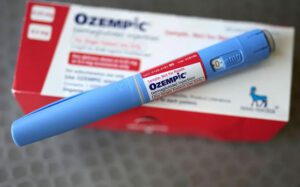
Novo Nordisk has slashed its full-year revenue and profit forecasts for the first time since launching its blockbuster weight-loss drug Wegovy, as unauthorised compounded versions of its GLP-1 drugs eat into sales — particularly in the United States, its largest market.
The Danish drugmaker, which also markets Ozempic for diabetes, now expects sales growth of 13% to 21% in constant currencies this year, down from its previous range of 16% to 24%. Operating profit is also forecast to be lower, at 16% to 24%, versus the prior estimate of 19% to 27%.
“We have reduced our full-year outlook due to lower-than-planned branded GLP-1 penetration, which is impacted by the rapid expansion of compounding in the US,” said Lars Fruergaard Jorgensen, Novo Nordisk CEO.
The US Food and Drug Administration (FDA) had allowed pharmacies to compound their own versions of semaglutide, the active ingredient in both Wegovy and Ozempic, to address supply shortages. But with supply now stabilised, the FDA has ordered these compounded versions off the market by May 22, offering Novo a potential reprieve.
Novo’s shares jumped 6.8% in Copenhagen following the news, despite the revised outlook, as the company signalled that prescription growth for Wegovy is expected to rebound once the FDA ban is enforced.
Despite Wegovy sales surging 83% year-on-year to $2.65 billion, growth was below analyst expectations and down from the previous quarter. Ozempic posted a 15% rise, slightly ahead of forecasts.
Novo estimates that compounding pharmacies have captured nearly a third of the US obesity drug market, undermining its dominance in the fast-growing GLP-1 sector.
“It’s unprecedented in our industry to have very large volumes of products flowing to patients that are not approved,” Jorgensen said.
Investor anxiety has also grown over intensifying competition, particularly from US rival Eli Lilly, which has gained traction with tirzepatide, branded as Mounjaro for diabetes and Zepbound for obesity. Lilly recently unveiled positive trial data for a weight-loss pill, heightening concerns over Novo’s future share in the injectable GLP-1 market.
Other pharmaceutical giants, including AstraZeneca, are racing to develop next-generation oral alternatives, which are cheaper to produce, easier to distribute, and may offer better patient outcomes by preserving muscle mass during weight loss.
To combat supply issues, Novo has made aggressive investments, including the $11 billion acquisition of three factories from Catalent, the US-based contract manufacturer, in a bid to scale up Wegovy production.
Jorgensen also addressed rising concerns over potential pharmaceutical tariffs from President Trump’s administration, stating that Novo is a net exporter from the US, where it operates multiple production sites and employs over 10,000 people.
“We have a strong US footprint,” he noted, emphasising that most of the company’s GLP-1 products are manufactured in the US and shipped globally.
While Novo’s GLP-1 franchise remains the market leader, the era of uninterrupted growth may be over as price pressure, regulatory shifts, and fierce competition disrupt the sector.
Investors will now look closely at how Novo navigates its US supply dynamics, defends its market share against new entrants, and transitions to the next phase of its product innovation pipeline — including potential oral therapies.
Read more:
Novo Nordisk cuts forecasts as Ozempic and Wegovy sales hit by US copycat versions






